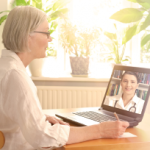Conclusions
I acknowledge my generational reservations in the new world of ambulatory medicine and that the new normal is far more familiar to newer generations of physicians. At its best, telemedicine can provide heretofore unavailable access for patients in chronically underserved areas and modes of care where electronically accessible laboratory and imaging results can be shared with patients similarly in possession of state-of-the-art devices. It has been a lifeline to our patients in the current pandemic, which has isolated us from our patients and our colleagues.
New technologies and a new generation of physicians more familiar with the deployment of those technologies may ameliorate many of the concerns I have raised. Physicians and patients will watch with interest and a measure of fear and wonder for what evolves.
The burden of proof lies with advocates of the new normal of telemedicine to demonstrate its equivalence in quality, access and cost, the three pillars of excellence—the central position of the care of the patient Francis Peabody cited in the well of the amphitheater at Boston City Hospital nearly a century ago endures.2
A parting hope is that medicine remains, as Edmund Pellegrino has described it, the most scientific of the humanities and the most humanistic of the sciences.3 As such, medicine must remain firmly anchored to its place in the healing relationship at all parts of the human journey.
Our profession has performed admirably in the COVID-19 crisis. Having tentatively won the war in the pandemic, we must not lose the ensuing peace of the post-COVID-19 era in patient care. To claim the care of ambulatory patients will be unchanged in the era of telemedicine is specious; it will be vastly different from traditional modes.
Our professional obligation is to ensure we remain on a trajectory of continuous improvement. The best of medical ethics and a commitment to the primacy of patients has prevailed in the COVID-19 crisis. Will that timeless ethic prevail in the new normal of post-COVID-19 telemedicine? Will the primacy of the good of the patient survive, and more importantly, will it flourish?
 Richard L. Allman, MD, MS, FACP, FACR, is a member of the clinical faculty in the Division of Rheumatology at Einstein Medical Center, Philadelphia, where he was an associate director of the residency program in internal medicine from 2002–18. He is also an associate professor of medicine at the Sidney Kimmel College of Medicine of Thomas Jefferson University. He has a Master of Science in healthcare ethics, and he is an editorial reviewer for Annals of Internal Medicine.
Richard L. Allman, MD, MS, FACP, FACR, is a member of the clinical faculty in the Division of Rheumatology at Einstein Medical Center, Philadelphia, where he was an associate director of the residency program in internal medicine from 2002–18. He is also an associate professor of medicine at the Sidney Kimmel College of Medicine of Thomas Jefferson University. He has a Master of Science in healthcare ethics, and he is an editorial reviewer for Annals of Internal Medicine.



